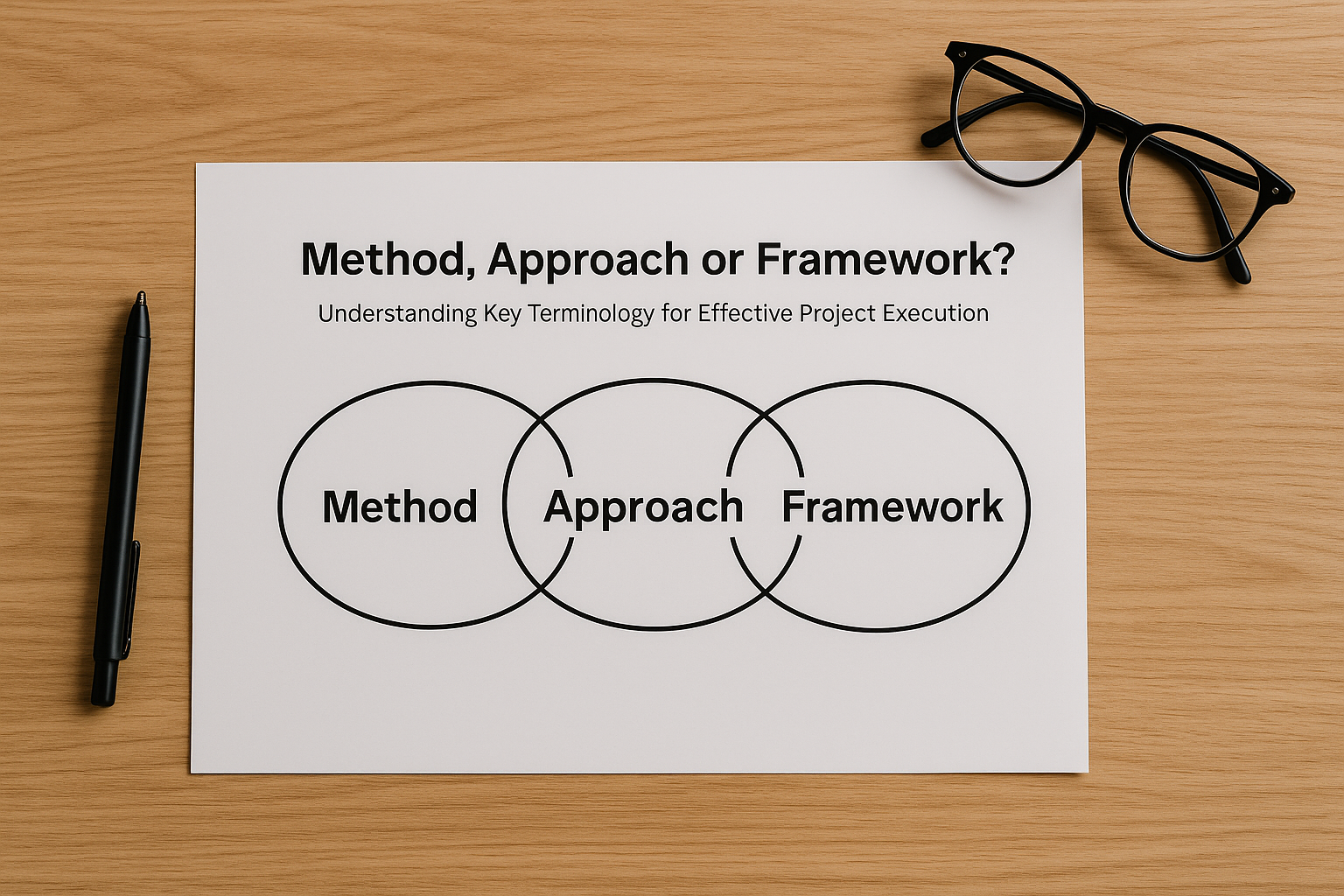
Clarifying Method, Approach, and Framework in Software Development
Understanding the key terminology differences between methods, approaches, and frameworks in software development project management for clearer communication and better project outcomes.
Clarifying Method, Approach, and Framework in Software Development
Understanding Key Terminology for Effective Project Execution
In the realm of software development project management, terminology matters. Words like "method," "approach," and "framework" are often used interchangeably in conversations, documentation, and strategic planning. Yet, each term carries a distinct meaning, and understanding their differences is essential for clarity, effective communication, and successful project delivery.
This article explores these foundational concepts, clarifies their unique characteristics, and illustrates their roles within the context of software development.
Introduction
Project management in software development is a complex tapestry woven from theory, practice, and experience. The discipline is shaped by evolving technological landscapes, shifting team dynamics, and the relentless pursuit of innovation. Amidst this complexity, the way we describe how we work—our methods, approaches, and frameworks—can influence everything from team alignment to the ultimate success or failure of a project.
Many practitioners, especially those new to the field, struggle to distinguish between these terms. Misusing them can lead to miscommunication, flawed planning, and unnecessary confusion. By drawing clear distinctions, teams can more effectively select, adapt, and apply these concepts to their unique project needs.
Defining the Terms
Let us begin by defining each term:
Method
What is a Method?
A method in software project management refers to a specific, structured way of accomplishing a particular task or activity. It is usually prescriptive, offering step-by-step instructions or rules to achieve defined outcomes. Methods are tangible, actionable, and replicable, making them useful for standardizing practices within or across projects.
Examples of methods include:
- Test-Driven Development (TDD): A software development method focused on writing tests before code, ensuring each new feature or function is validated through automated tests.
- Critical Path Method (CPM): Used in project scheduling, CPM identifies the longest sequence of dependent tasks and determines the minimum project duration.
- User Story Mapping: A method for organizing and prioritizing requirements by visualizing user journeys and interactions.
Methods are granular in nature. They typically address "how" something is done and can be embedded within larger processes or frameworks. Importantly, methods are often interchangeable—teams may swap TDD for Behavior-Driven Development (BDD), for example, to better suit their project goals.
Approach
What is an Approach?
An approach is a broader, high-level philosophy or orientation toward solving problems or managing processes. It represents a mindset, a way of thinking, or a strategic direction that guides how work is accomplished. Approaches are less prescriptive than methods; they set the tone and context for choosing which methods or frameworks to use.
Examples of approaches include:
- Agile Approach: Emphasizes iterative development, collaboration, adaptability, and continuous improvement. It guides teams to embrace change and deliver value incrementally.
- Waterfall Approach: Advocates for a linear, sequential process where each phase of development must be completed before the next begins.
- Lean Approach: Focuses on maximizing value by eliminating waste and streamlining processes.
Approaches answer the question of "why" and "in what manner" work should be done. They shape the selection of methods and frameworks but do not typically dictate the specific steps involved in execution.
Framework
What is a Framework?
A framework in software project management is a scaffold or structure that organizes and integrates multiple methods, practices, and roles within a coherent system. Frameworks provide an overarching set of guidelines, principles, and processes, but allow for customization and adaptation to specific project needs.
Examples of frameworks include:
- Scrum: An agile framework for organizing work into sprints, defining roles (Scrum Master, Product Owner, Development Team), and managing iterative cycles of planning, execution, and review.
- Scaled Agile Framework (SAFe): A framework designed to scale agile practices across large organizations, integrating principles, roles, events, and artifacts at multiple levels.
- PRINCE2: A process-driven project management framework that provides detailed guidance on managing projects from initiation to closure.
Frameworks are comprehensive. They provide structure, enable standardization across teams or organizations, and specify processes, roles, and artifacts. However, they are usually flexible enough to incorporate different methods and can be adapted to align with various approaches.
Comparing the Concepts
To understand how these terms relate to one another, consider this analogy:
- The approach is like your travel philosophy—do you prefer to explore spontaneously, plan every detail, or keep things lean and minimal?
- The framework is your itinerary—a structured plan that organizes your travel days, accommodations, and main activities.
- The methods are your means of transport—do you walk, cycle, take the train, or drive?
Each is distinct, yet interdependent. The approach influences the choice of framework. The framework provides the structure within which methods are implemented.
Why the Distinction Matters
Precise terminology is essential for several reasons:
- Clarity: Teams communicate more effectively and avoid misunderstandings.
- Alignment: Stakeholders can agree on strategy, expectations, and roles.
- Adaptability: Clear distinctions allow teams to tailor their process to changing needs without confusion.
- Continuous Improvement: Teams can reflect on what works and what doesn't, adjusting their approach, framework, or methods as necessary.
Misusing these terms can lead to mismatched expectations. For instance, choosing "Scrum" as a method, when it is in fact a framework, may result in incomplete adoption, missed benefits, or resistance from team members.
Common Misconceptions
Let's address a few frequent errors:
- Calling Scrum a Method: Scrum is a framework—it integrates roles, events, and artifacts. Referring to it as a method oversimplifies its scope.
- Confusing Agile as a Framework: Agile is an approach—a set of guiding principles. Frameworks like Scrum or Kanban operationalize Agile values.
- Overusing "Methodology": Many use "methodology" interchangeably with method, approach, or framework, contributing to confusion. Methodology refers to the systematic, theoretical analysis of methods applied to a field.
Practical Examples
Imagine a software team tasked with building a new mobile app. The team:
- Chooses an Agile approach, favoring adaptability and customer collaboration.
- Decides on the Scrum framework to provide structure for daily stand-ups, sprint reviews, and retrospectives.
- Implements TDD (Test-Driven Development) as a method for writing reliable code.
Here, the approach sets the vision, the framework provides the structure, and the method guides specific activities.
Conclusion
In software development project management, understanding the difference between method, approach, and framework is paramount. Each term serves a unique purpose:
- Method: Specific, actionable process or technique
- Approach: Guiding philosophy or orientation
- Framework: Structured system integrating multiple elements
By using these terms properly, teams improve communication, streamline planning, and maximize project success. As technology evolves and project environments grow more complex, clarity in language is not just helpful—it is essential for navigating the road ahead.

Erinn Mahoney
Lead Scrum Master & Founder
Passionate about agile transformation and building high-performing development teams. 10+ years experience in software development and agile coaching.



